Perhaps any movie could have marked the watershed moment of Ryan Smith’s young adulthood, but on that midsummer evening in 2002, it was M. Night Shyamalan’s Signs that colored the mood at the Sky-Vue Drive-In Theatre on the dusty outskirts of Lamesa.
Smith, in his early 20s and fresh out of his first year of law school at SMU, was in West Texas to learn from his grandfather about the family businesses—bits about farming, real estate, oil and gas, and, most notably, the movie theater business. Smith’s grandparents, R.A. “Skeet” and Sarah Noret, opened the Sky-Vue in 1948, and he grew up hearing stories about the iconic drive-in, like the time a then-unknown Buddy Holly played atop the projection room or when Albert Noret, Smith’s great-grandfather, invented the now-legendary Chihuahua Sandwich, a quintessentially Tex-Mex concoction of homemade chili meat and pimento cheese, shredded cabbage and diced onions between two tostada shells with a side of jalapeño. Yet, despite his family’s long history with the theater, Smith had never seen a movie at the drive-in before that evening 17 years ago.
He had just finished helping out with a rush on the concession stand when he grabbed some food for himself and went outside to catch a bit of the movie. Sitting in his car and crunching away on a Chihuahua Sandwich, he felt enchanted by the whole scenario—the collective energy of the moviegoers that surrounded him in lawn chairs and truck beds, the sound of their laughter at the film’s tension breakers—and thought, “Man, this has to be preserved and shared.”
He gazed through his open sunroof at the stars glowing over the Llano Estacado and waited for the aliens to invade Mel Gibson’s on-screen world.
“It was a communal experience, and yet, I was sitting in the privacy of my own vehicle, enjoying dinner,” he says today. “It was an experience that I had never had before but had heard about. And I now understood why the experience was so beloved.”
Smith never made it back to law school. He instead felt a calling to deliver the drive-in experience to others. Just over a year after that night at the Sky-Vue, aided by investments from his family, he opened his first theater, Stars & Stripes Drive-In Theatre in Lubbock.
“So that began the journey,” he says, “to try to draw inspiration from what my granddad did and share it with [more] people.”

Teens, from left, Emma Travland, Allison James, Lexi Cole and Kate Darsey cram into the front seat at the Stars & Stripes Drive-In Theatre in New Braunfels to enjoy a scary movie.
Dave Shafer
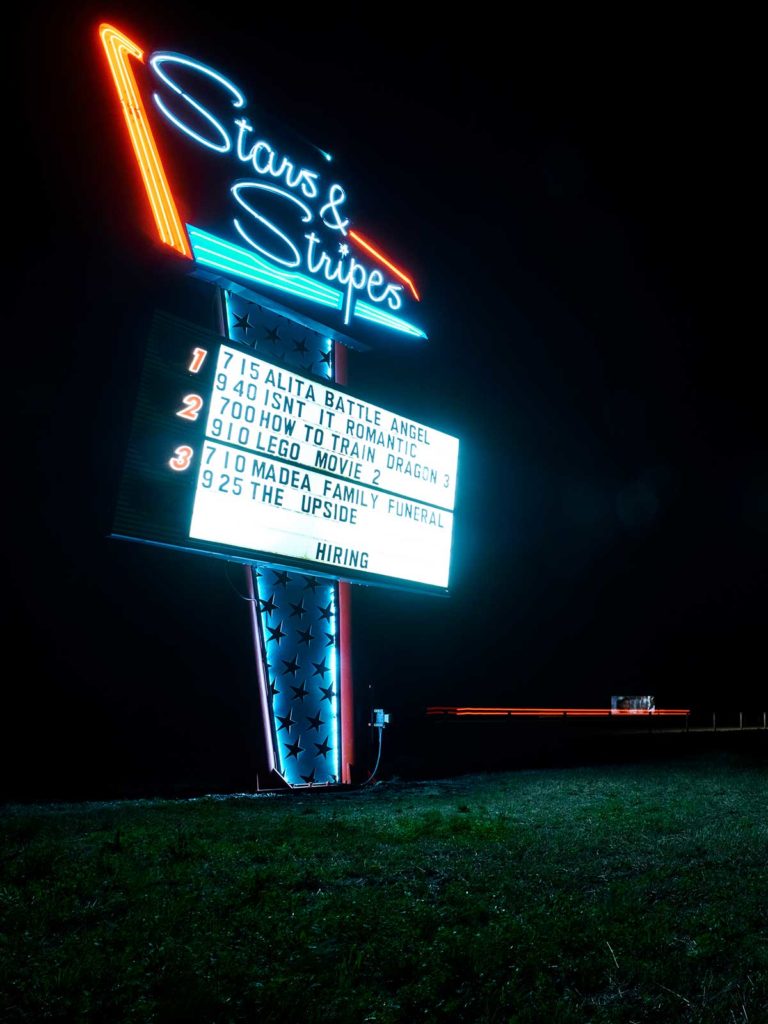
The Stars & Stripes Drive-In Theatre’s marquee in New Braunfels can be seen for miles.
Dave Shafer
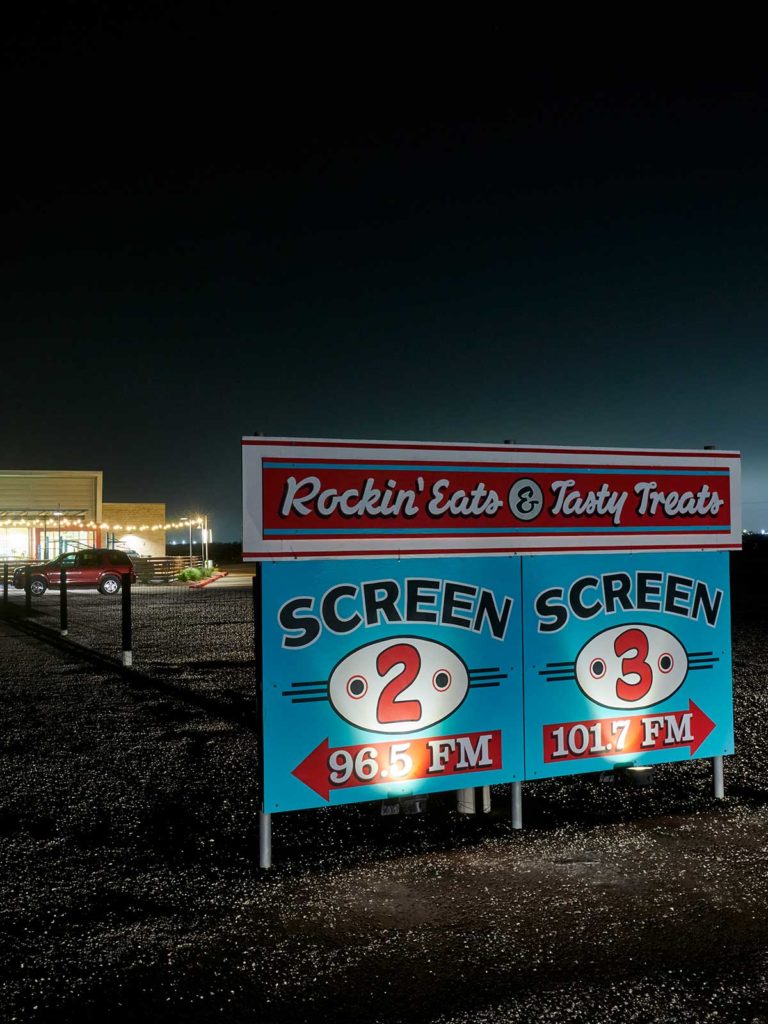
Pick a movie, pick a screen and pick an FM station to listen to the movie through your car speakers at the Stars & Stripes Drive-In Theatre in New Braunfels.
Dave Shafer

The expansive concession stand at New Braunfels’ Stars & Stripes Drive-In is a main attraction.
Dave Shafer

Stars & Stripes Drive-In owner Ryan Smith checks one of the digital projectors ahead of a show at his Lubbock theater.
Travis P. Hill
Smith, who also owns land in Lyntegar Electric Cooperative’s service territory, has since expanded the Stars & Stripes brand with a second location, in New Braunfels, south of Austin, and today his operation accounts for two of fewer than 20 drive-ins open for business in the Lone Star State. Some of these theaters stand as paint-chipped remnants of a bygone era, when the outdoor double feature dominated the cinema experience and some 400 drive-ins dotted the Texas landscape. Others, like Fort Worth’s Coyote Drive-In, inject a twist of modernity into that paradigmatic pastime of the mid-20th century. But all of Texas’ surviving drive-in theaters share at least one quality: the promise of a singular form of entertainment served with a healthy dose of nostalgia—bolstered by the dedication of theater owners to preserving the pastime.
The first drive-in theater in the United States opened in Camden, New Jersey, in 1933, and by the late 1950s, there were more than 4,000 drive-ins throughout the country. They were so widespread and popular that to some degree, says D. Vogel, administrative secretary of the United Drive-In Theatre Owners Association, “drive-in movie theaters built Hollywood.”
But by 1980, the number of drive-ins had dropped to about 2,400, and a steady decline continued over the ensuing decade, the result of a combination of factors, including land value increases that made it financially attractive for owners to sell their properties to developers, retirements of aging owners and increased competition from entertainment options like home video and multiplexes.

Coyote Drive-In’s big screen set against the vast Texas sky at twilight.
Dave Shafer
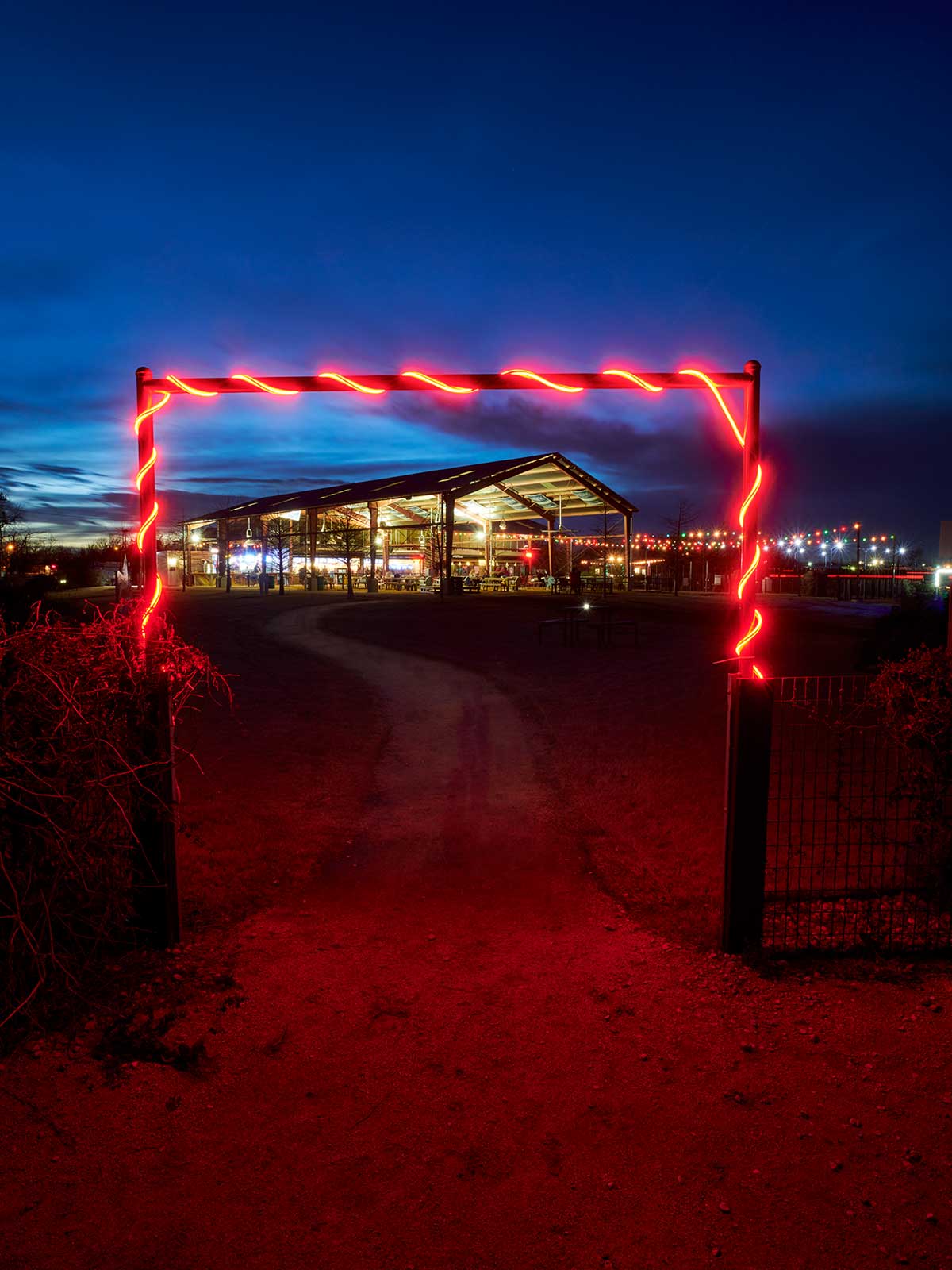
One of the gates and paths at Fort Worth’s Coyote Drive-In that lead to the pavilion featuring a partylike atmosphere with food, craft beers, a playground and restrooms.
Dave Shafer

Lala Watkins prepares for hungry moviegoers at Coyote Drive-In in Fort Worth.
Dave Shafer
Hollywood’s digital revolution—a shift from 35 mm film prints to digital projection that began in the early 2000s—put the nail in the coffin for some drive-ins. A digital projector with a bulb strong enough to project across a field can cost upward of $70,000, a prohibitive expense for the mom and pop operations these theaters tend to be. But drive-ins that didn’t make the switch would be left without new movies to show.
Today, there are fewer than 400 drive-ins in the U.S. Though their numbers are small, these theaters continue to offer an engrossing experience wholly distinct from their indoor counterparts. A ticket to the drive-in typically provides double-feature entertainment for a lower price than one movie at an indoor theater. The food, also at a reasonable price point, tends to go beyond the standard fare of popcorn, soda and candy. And then there’s the freedom granted by the outdoor environment.
“Your options are wide open,” Vogel says. “You could just get up and look at the night sky. Or you could just take a quiet stroll around the field and watch families laughing and having a good time together. Or, you could get through the movie simply by taking a little nap until the next one came on.”
It’s the privilege of providing that experience that keeps many drive-in owners in the game. The defining trait of those who remain, Vogel says, is “a genuine love for this business. That’s what it takes.”
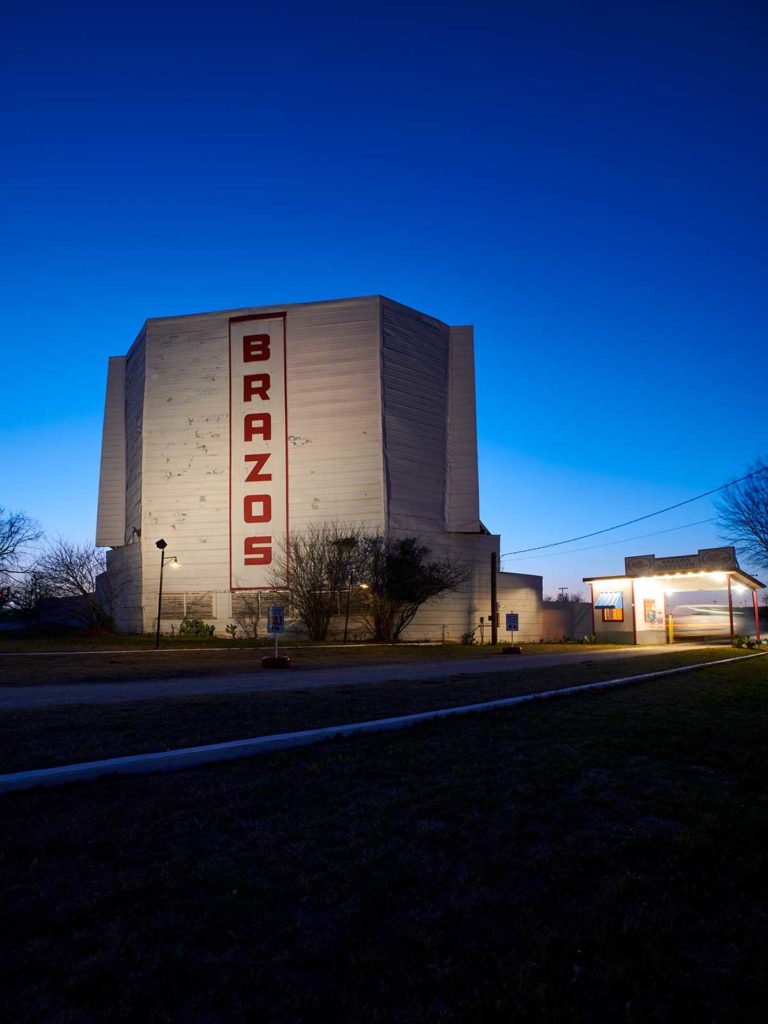
The original screen architecture and name of the Brazos Drive-In Theatre in Granbury rises from a field, beckoning moviegoers.
Dave Shafer

Cubbies hold letters of the alphabet that are used on the main marquee at Brazos Drive-In Theatre in Granbury.
Dave Shafer

Jennifer Miller, owner of the Brazos Drive-In Theatre in Granbury, makes sure everything is stocked and ready in the concession stand.
Dave Shafer
And that’s a love that Jennifer Miller knows well. She’s the owner of Brazos Drive-In Theatre in Granbury, one of the oldest drive-ins in Texas. First opened in 1952, Brazos has welcomed moviegoers every year since, closing only for the winter offseason. Miller is responsible for more than half of that track record.
She’s poured her heart and wallet into the theater since she bought it in 1985. She runs the single-screen operation with just a handful of employees and works the concession stand every night it’s open. She shelled out the money for the expensive equipment when digital conversion became necessary and set up a minimuseum featuring the drive-in’s old film projector and other memorabilia in the vintage snack bar. The 67-year-old has even donned a bunny suit to entertain kids around Easter.
For Miller, the theater isn’t about making money. It’s about preserving a piece of history and providing family-friendly fun for her patrons. “I just want to be able to make enough money to keep improving it, so everyone can enjoy it. I guess that’s my passion, my focus,” she says. “If all I do is save the drive-in, then it’s been very, very rewarding for me.”
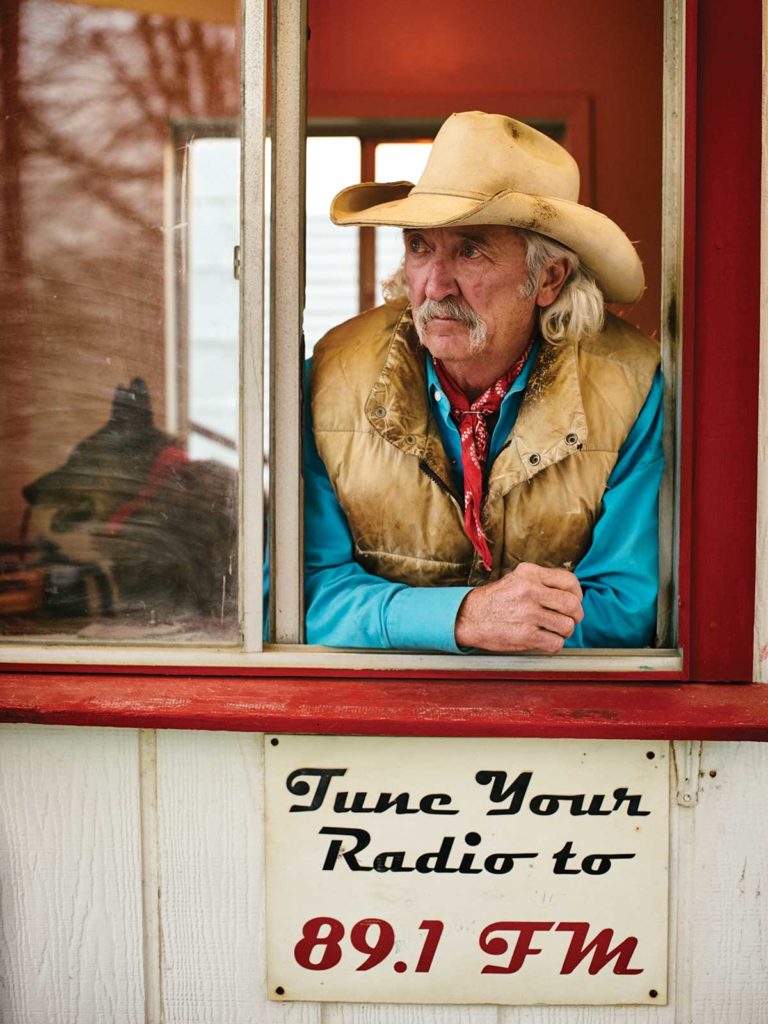
Cowboy Fred works the box office at Brazos Drive-In.
Dave Shafer

As the sun sets in Granbury, Cowboy Fred awaits the next vehicle at Brazos Drive-In.
Dave Shafer
The sense of nostalgia is intrinsic to the historic grounds of the Brazos theater. Newer drive-ins, like the Blue Starlite Mini Urban Drive-In in Austin, must work to evoke the feeling. For Blue Starlite owner Josh Frank, that requires more than showing a movie outdoors. “The movie is a part of the experience, but it’s maybe 30%,” he says.
Nestled in a partially paved clearing behind a Moose Lodge, the Blue Starlite consists of two mobile screens and a scattering of vintage and aging trailers—some of which can be rented for parties—and signage fonts that scream midcentury diner.
“I love nostalgia,” says Frank, who likens his theater more to an interactive show than a simple venue to catch a flick. “It’s about the classic culture, the nostalgia, the ’50s mentality. I would probably open a malt shop before I opened an indoor movie theater.”
The quest to revive a fading era is also what got Sam Kirkland, South Plains Electric Cooperative member, into the theater business. Kirkland grew up working for the Norets at the Sky-Vue in Lamesa, starting in 1957 and into the 1960s. In those years, he says, the theater was “the pride and joy of the town.”
Things had changed, though, by the late ’70s, when Kirkland was driving by the theater one day to find it closed and overgrown with weeds. He decided to clean it up and help the Norets reopen. Within a year, he bought the theater, which he and his wife kept alive until a fire destroyed the snack bar in 2015.
The demise of the Sky-Vue meant more than the loss of an entertainment attraction for the Lamesa community. It also represented the passing of a place where generations of memories were made, Kirkland says.
“It was a big deal,” he says. “We had a wonderful playground. I kept all of the original toys repaired. Parents would bring their kids to the Sky-Vue and say, ‘These are the same toys I played on when I was your age.’ ”
Though the Sky-Vue is no more, Kirkland and others are keeping the tradition alive. Hungry theatergoers can still find the famous Chihuahua Sandwich at Midland’s Big Sky Drive-In, where Kirkland is part owner, as well as at the Stars & Stripes in Lubbock. For those who favor libations with their movies, the Coyote Drive-In in Fort Worth serves up beer and wine, often paired with live music before the show, at its canteen—the sort of appurtenances audiences have come to expect from modern theaters.
Whether it’s a night out for the whole family or a romantic evening for two under the stars, there’s still a drive-in theater in Texas to meet the occasion. And it’s sure to outshine a stuffy night at the mall multiplex.
“The drive-in can give you something that the indoors can’t,” Kirkland says, “and that’s freedom.”


